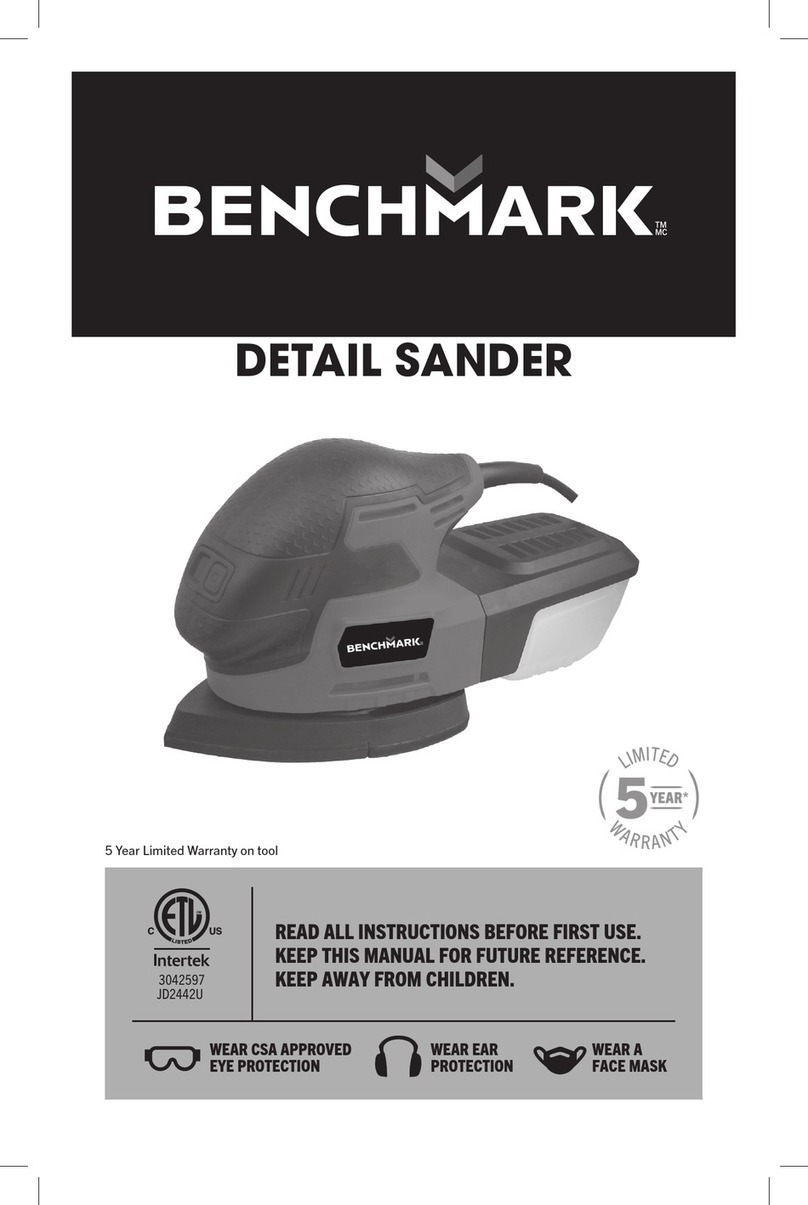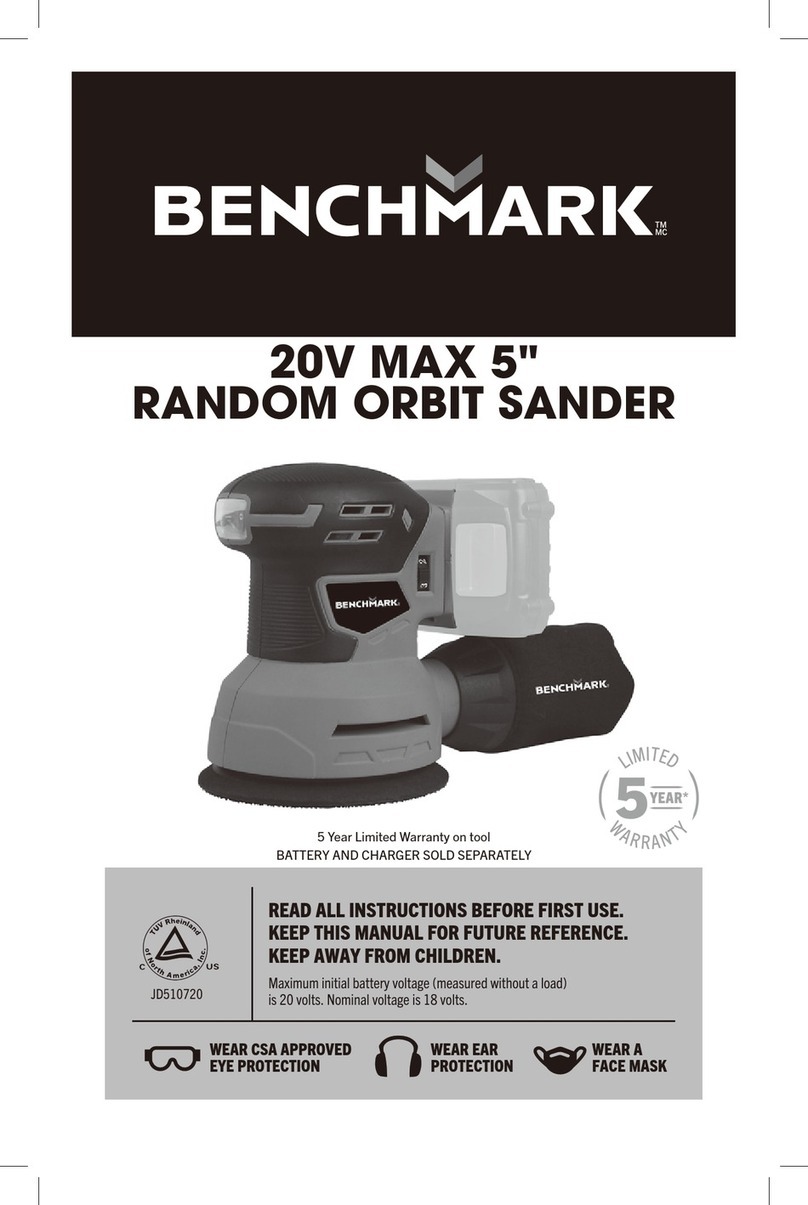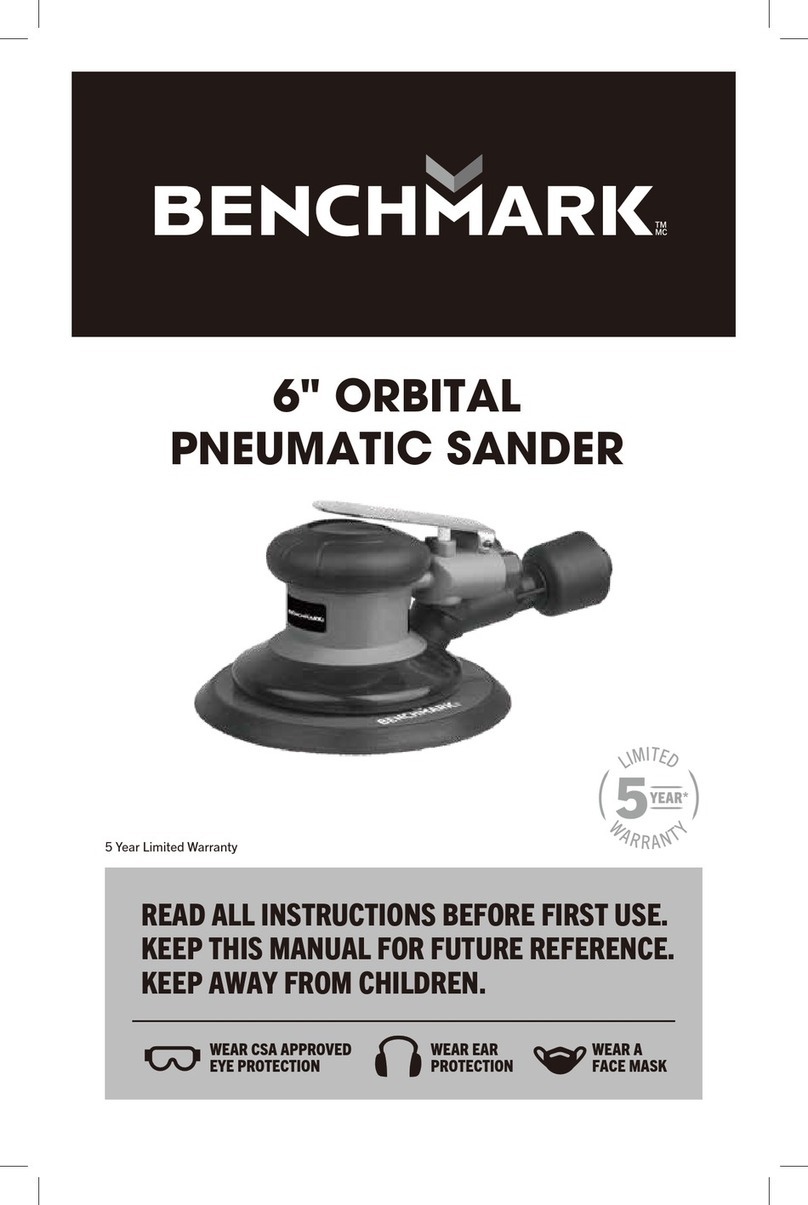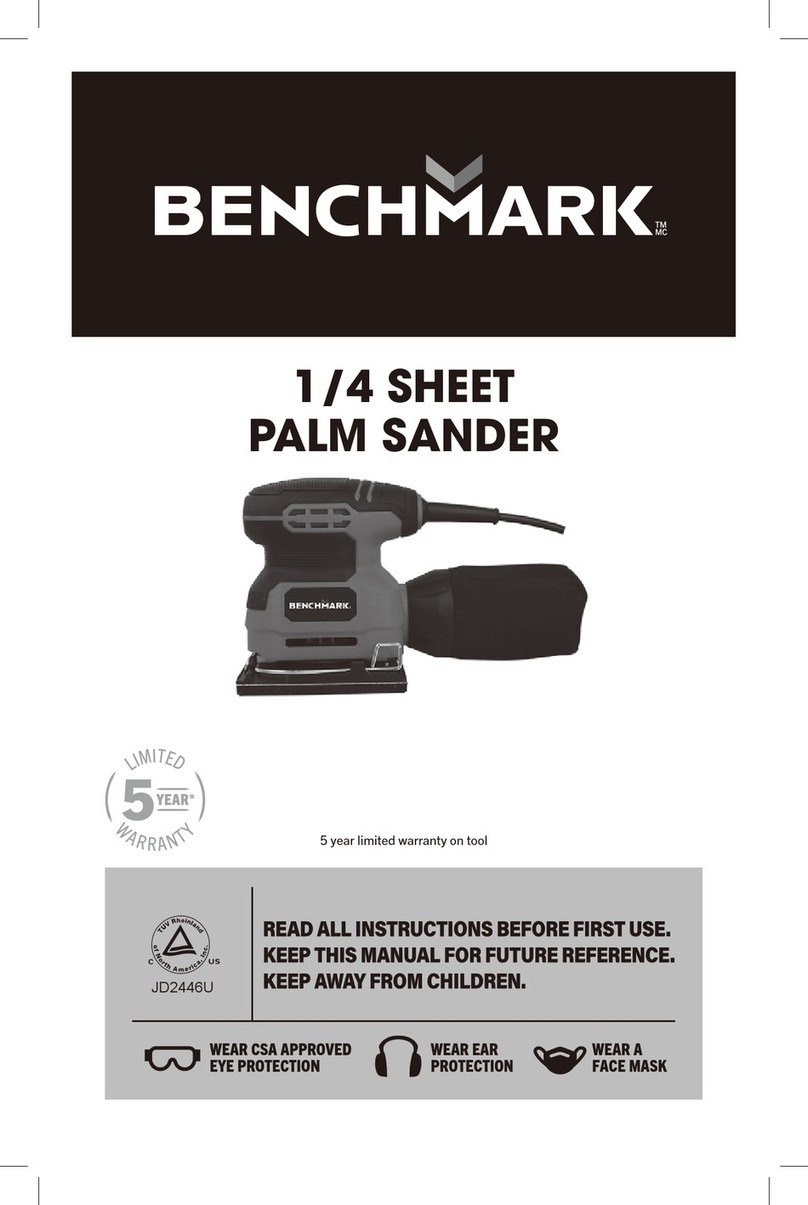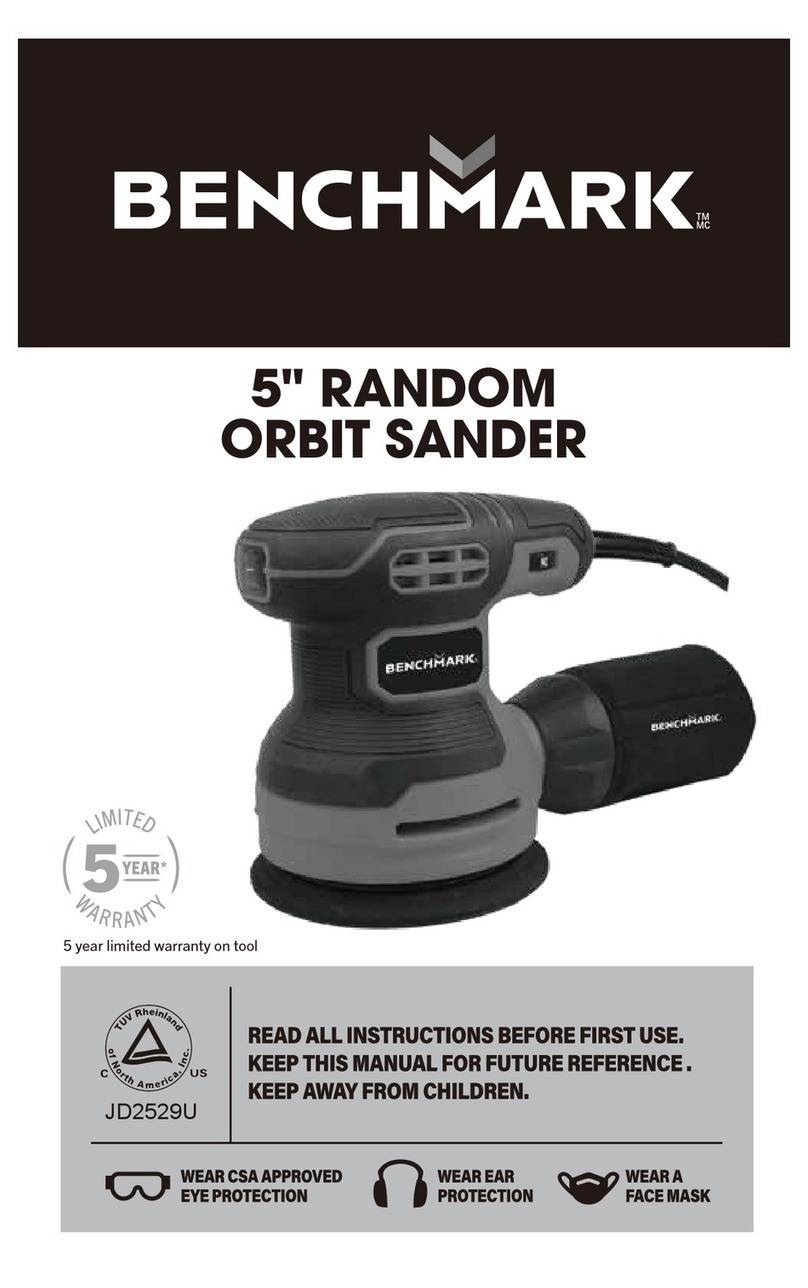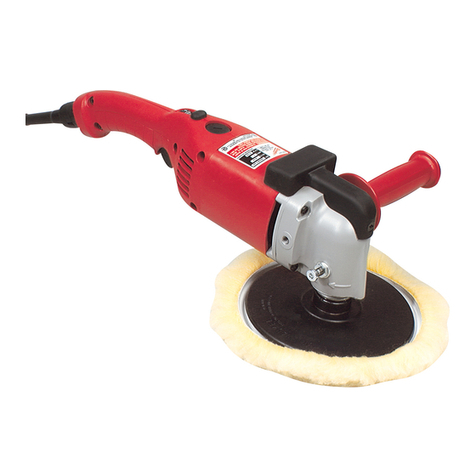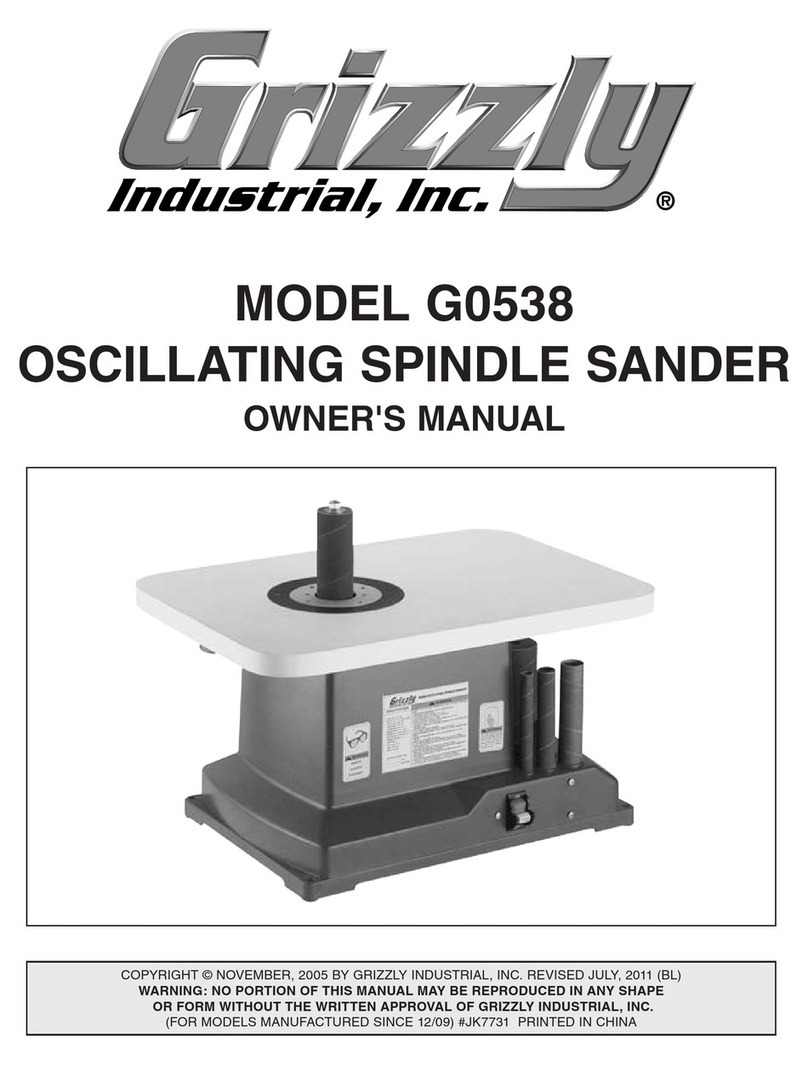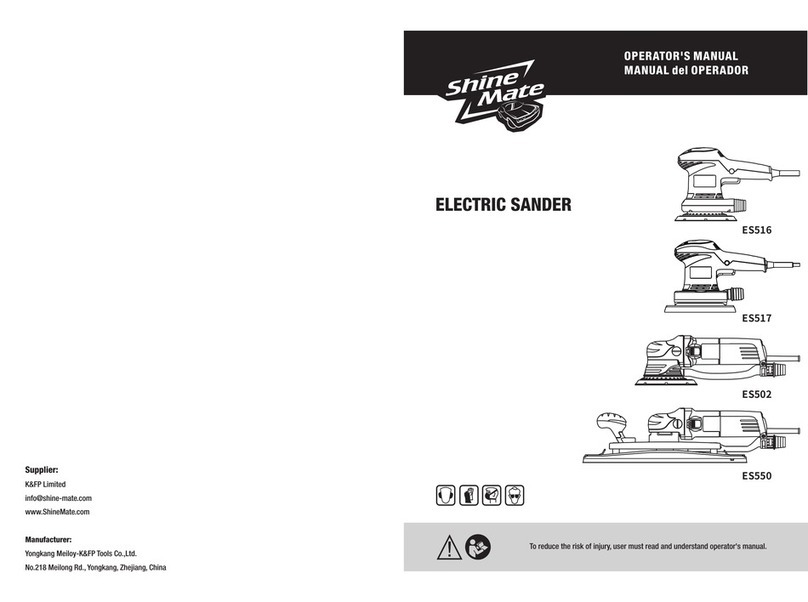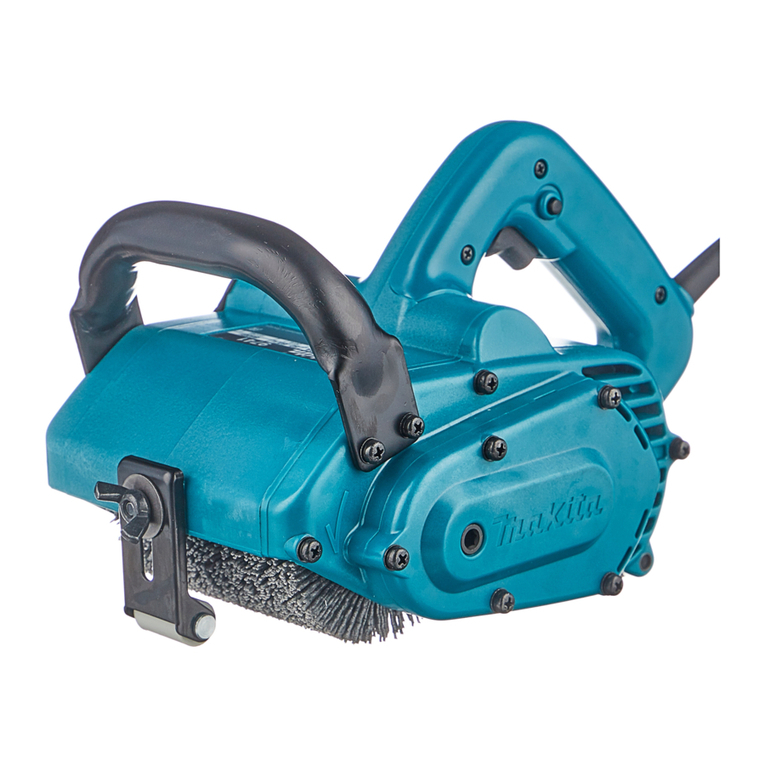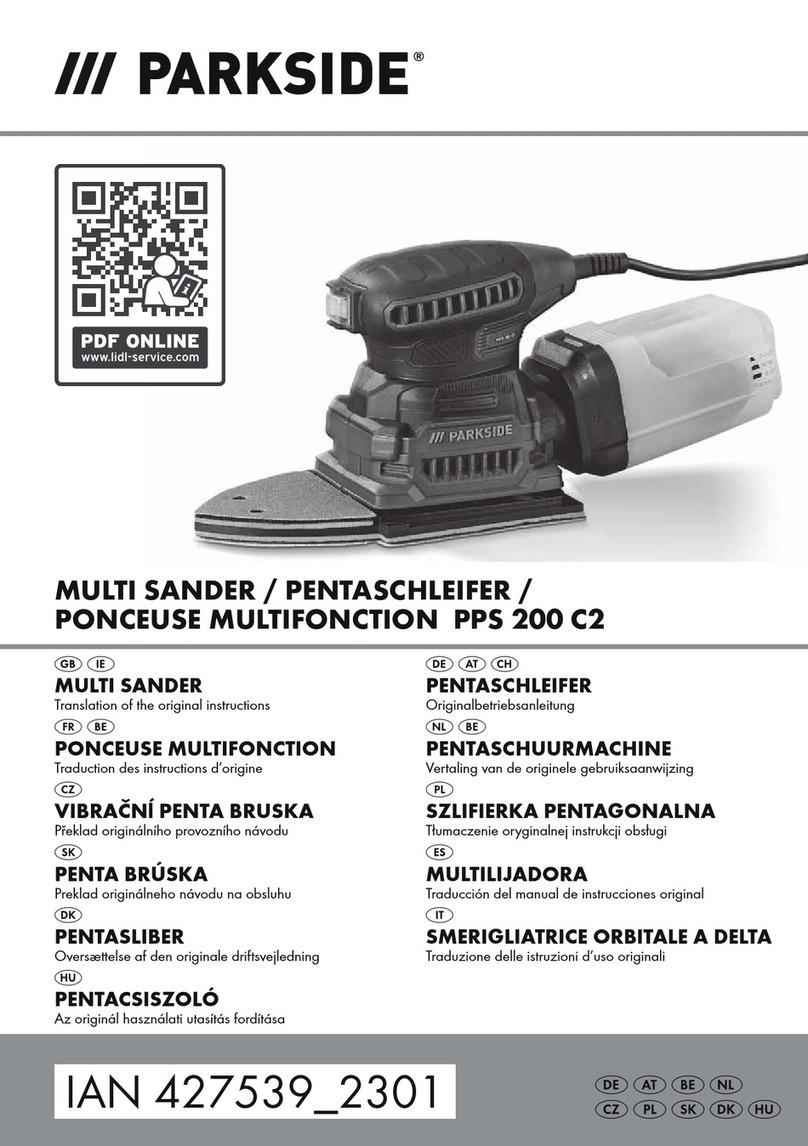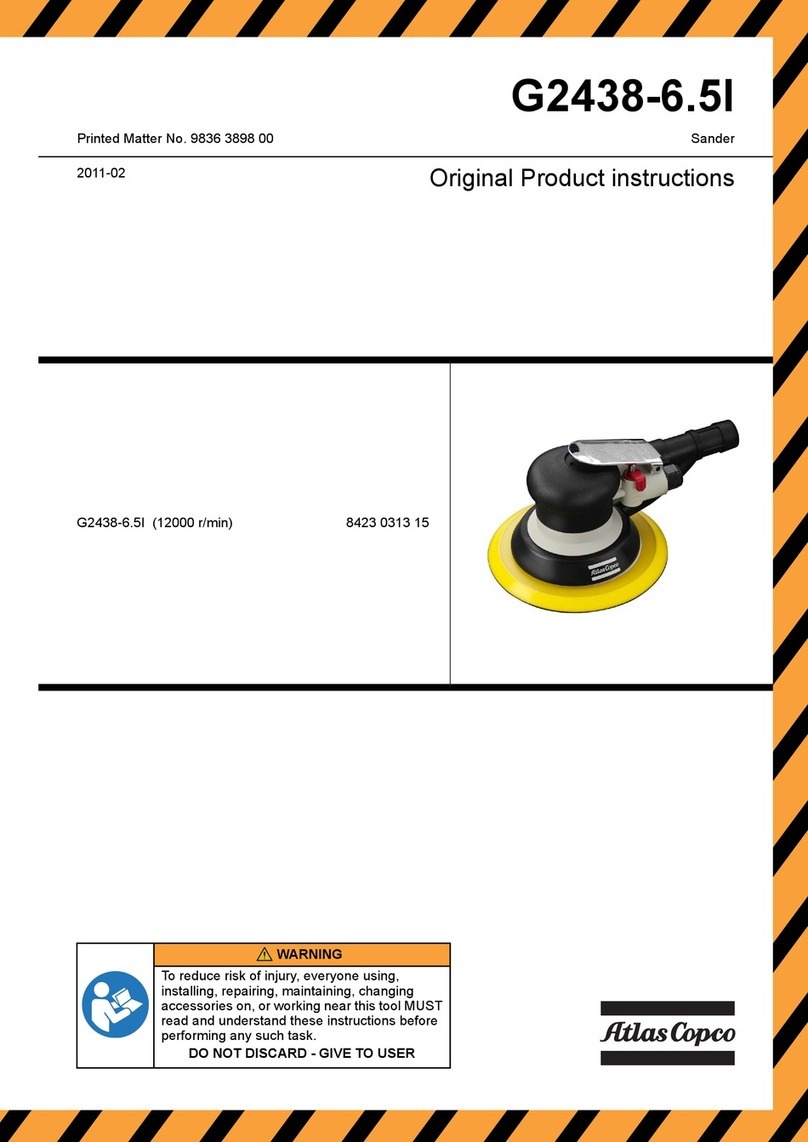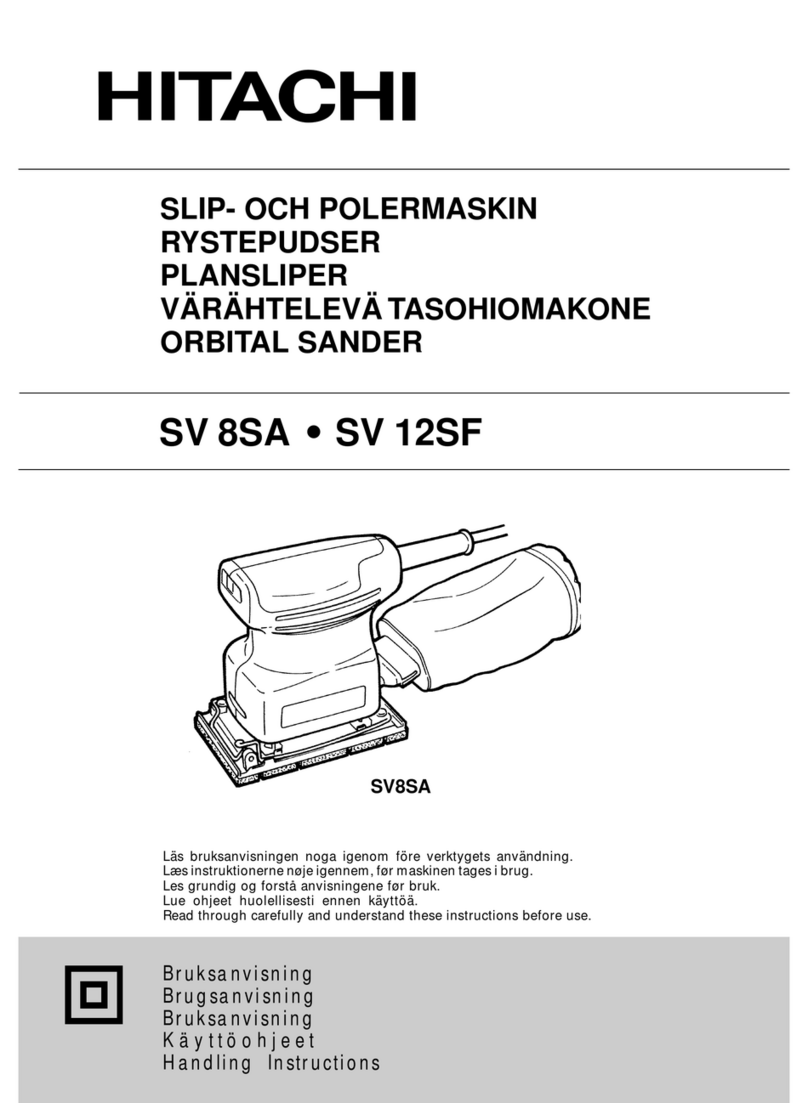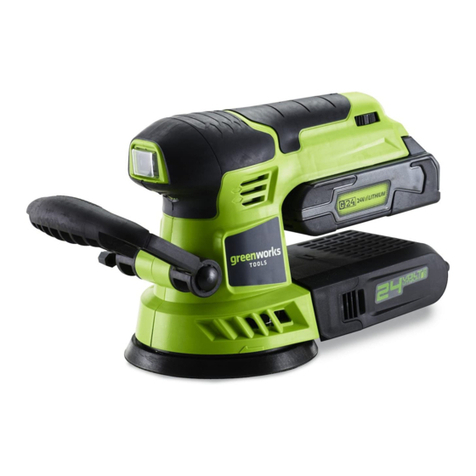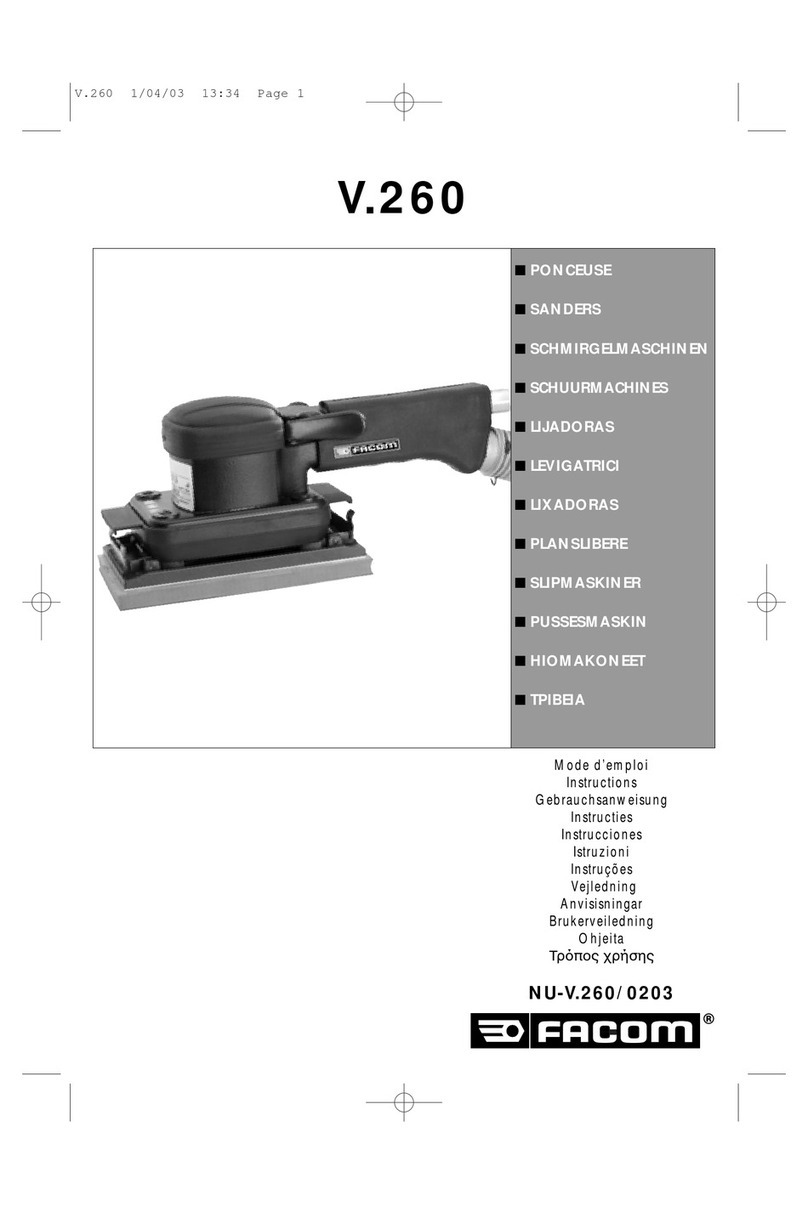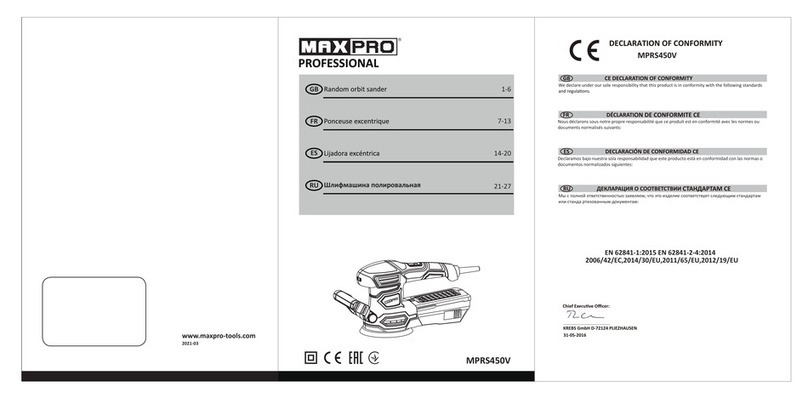Benchmark 2.2AMP VS 1/3 User manual

WEAR CSA APPROVED
EYE PROTECTION
WEAR EAR
PROTECTION
WEAR A
FACE MASK
1/3 SHEET SANDER
5 year limited warranty on tool
JD2642U

1
PRODUCT SPECIFICATIONS
BENCHMARK 2.2AMP VS 1/3 SHEET SANDER
Rating 120 V, 60 Hz AC
Amperes 2.2 A
Speed 6,000-12,000 OPM (no load)
Sanding pad size 1/3 sheet 3-1/2" x 7-3/8" (90 x 187mm)
Weight 4.6 Lb. (2.1Kg)
NEED ASSISTANCE?
Call us on our toll- free customer support line:
1-866-349-8665 (Monday through Friday 9am – 5pm Eastern Standard Time)
• Technical questions
• Replacement parts
• Parts missing from package

1262-302
1/3 SHEET SANDER
2
TABLE OF CONTENTS
Product Specifications .................................................................................. 1
Table of Contents .......................................................................................... 2
General Safety Warnings ............................................................................ 3-5
Specific Safety Rules ..................................................................................... 6
Guidelines for Extension Cords ...................................................................... 7
Symbols ........................................................................................................ 8
Know your Sheet Sander ............................................................................... 9
Assembly and Operating ........................................................................ 10-13
Maintenance ............................................................................................... 14
Exploded View ............................................................................................ 15
Parts List ............................................................................................... 16-17
Warranty ..................................................................................................... 18

3
GENERAL SAFETY WARNINGS
WARNING:
Before using this tool or any of its accessories, read this manual and follow all Safety
Rules and Operating Instructions. The important precautions, safeguards and
instructions appearing in this manual are not meant to cover all possible situations.
It must be understood that common sense and caution are factors which cannot be
built into the product.
SYMBOL MEANING
ALWAYS WEAR EYE PROTECTION THAT CONFORMS WITH CSA
Z94.3 or ANSI SAFETY STANDARD Z87.1
FLYING DEBRIS can cause permanent eye damage. Prescription
eyeglasses ARE NOT a replacement for proper eye protection.
Non-compliant eyewear can cause serious injury if broken during
the operation of a power tool.
Use hearing protection, particularly during extended periods of
operation of the tool, or if the operation is noisy.
WEAR A DUST MASK THAT IS DESIGNED TO BE USED WHEN
OPERATING A POWER TOOL IN A DUSTY ENVIRONMENT.
Dust that is created by power sanding, sawing, grinding,drilling, and
other construction activities may contain chemicals that are known to
cause cancer, birth defects, or other genetic abnormalities.
These chemicals include:
• Lead from lead-based paints
• Crystalline silica from bricks, cement, and other masonry products
• Arsenic and chromium from chemically treated lumber
The level of risk from exposure to these chemicals varies, according to
how often this type of work is performed. In order to reduce exposure
to these chemicals, work in a well-ventilated area, and use approved
safety equipment, such as a dust mask that is specifically designed to
filter out microscopic particles.
ELECTRICAL SAFETY
WARNING:
To avoid electrical hazards, fire hazards or damage to the tool, use proper circuit
protection.
This tool is wired at the factory for 120V AC operation. It must be connected to a
120V AC, 15 A circuit that is protected by a time-delayed fuse or circuit breaker. To
avoid shock or fire, replace power cord immediately if it is worn, cut or damaged in
any way.

1262-302
1/3 SHEET SANDER
4
POWER TOOL SAFETY
WARNING:
Read all safety warnings and instructions. Failure to follow the warnings and
instructions may result in electric shock, fire and/or serious injury.
SAVE ALL WARNINGS AND INSTRUCTIONS FOR FUTURE REFERENCE.
WORK AREA SAFETY
Keep work area clean and well lit. Cluttered or dark areas invite accidents.
Do not operate power tools in explosive atmospheres, such as in the presence
of flammable liquids, gases or dust. Power tools create sparks which may ignite
the dust or fumes.
Keep children and bystanders away while operating a power tool. Distractions
can cause you to lose control.
ELECTRICAL SAFETY
Power tool plugs must match the outlet. Never modify the plug in any way. Do
not use any adapter plugs with earthed (grounded) power tools. Unmodified
plugs and matching outlets will reduce risk of electric shock.
Avoid body contact with earthed or grounded surfaces such as pipes, radiators,
ranges, and refrigerators. There is an increased risk of electric shock if your body
is earthed or grounded.
Do not expose power tools to rain or wet conditions. Water entering a power tool
will increase the risk of electric shock.
Do not abuse the cord. Never use the cord for carrying, pulling, or unplugging
the power tool. Keep cord away from heat, oil, sharp edges or moving parts.
Damaged or entangled cords increase the risk of electric shock.
When operating a power tool outdoors, use an extension cord suitable for
outdoor use. Use of a cord suitable for outdoor use reduces the risk of electric
shock.
If operating a power tool in a damp location is unavoidable, use a residual
current device (RCD) protected supply. Use of a ground fault circuit interrupter
(GFCI) reduces the risk of electric shock.
PERSONAL SAFETY
Stay alert, watch what you are doing and use common sense when operating a
power tool. Do not use a power tool while you are tired or under the influence
of drugs, alcohol, or medication. A moment of inattention while operating power
tools may result in serious personal injury.
Use personal protective equipment. Always wear eye protection. Protective
equipment such as dust mask, non-skid safety shoes, hard hat, or hearing
protection used for appropriate conditions will reduce personal injuries.

5
connecting to power source and/or battery pack, picking up or carrying the
tool. Carrying power tools with your finger on the switch or energizing power tools
that have the switch on invites accidents.
Remove any adjusting key or wrench before turning the power tool on. A wrench
or a key left attached to a rotating part of the power tool may result in personal
injury.
Do not overreach. Keep proper footing and balance at all times. This enables
better control of the power tool in unexpected situations.
Dress properly. Do not wear loose clothing or jewellery. Keep your hair,
clothing, and gloves away from moving parts. Loose clothes, jewellery or long hair
can be caught in moving parts.
If devices are provided for the connection of dust extraction and collection
facilities, ensure these are connected and properly used. Use of dust collection
can reduce dust-related hazards.
POWER TOOL USE AND CARE
Do not force the power tool. Use the correct power tool for your application.
The correct power tool will do the job better and safer at the rate for which it was
designed.
Any power
tool that cannot be controlled with the switch is dangerous and must be repaired.
Disconnect the plug from the power source and/or the battery pack from the
power tool before making any adjustments, changing accessories, or storing
power tools. Such preventive safety measures reduce the risk of starting the power
tool accidentally.
Store idle power tools out of the reach of children and do not allow persons
unfamiliar with the power tool or these instructions to operate the power tool.
Power tools are dangerous in the hands of untrained users.
Maintain power tools. Check for misalignment or binding of moving parts,
operation. If damaged, have the power tool repaired before use. Many accidents
are caused by poorly maintained power tools.
Keep cutting tools sharp and clean. Properly maintained cutting tools with sharp
cutting edges are less likely to bind and are easier to control.
Use the power tool, accessories and tool bits etc. in accordance with these
instructions, taking into account the working conditions and the work to be
performed.
result in a hazardous situation.
SERVICE
Have your power tool serviced by a qualified repair person using only identical
replacement parts. This will ensure that the safety of the power tool is maintained.

1262-302
1/3 SHEET SANDER
6
SPECIFIC SAFETY RULES FOR 1/3 SHEET
SANDERS
WARNING:
Know your 1/3 sheet sander. Do not plug in the sander until you have read and
understand this Instruction Manual.
Learn the tool’s applications and limitations, as well as the specific potential
hazards related to this tool. Following this rule will reduce the risk of electric
shock, fire, or serious injury.
Always wear eye protection. Any power tool can throw foreign objects
into your eyes and cause permanent eye damage. ALWAYS wear
safety goggles (not glasses) that comply with ANSI safety standard
Z87.1.
Everyday glasses have only impact resistant lenses. They ARE NOT safety glasses.
WARNING: Glasses or goggles not in compliance with ANSI Z87.1 could
cause serious injury when they break.
WARNING: Always use a dust mask when sanding.
WARNING: Always use hearing protection when sanding, particularly during
extended periods of operation.
WARNING: Always unplug the tool from the power source before changing
the sandpaper and when cleaning the tool.
Do not wear gloves, neckties or loose clothing.
Secure the workpiece. Use clamps or a vise to hold the work when practical. It is
safer than using your hand and it frees both hands to operate the tool.
Do not sand material too small to be securely held.
Make sure there are no nails or foreign objects in the part of the workpiece to be
sanded.
Always keep hands out of the path of the sanding pad. Avoid awkward hand
positions where a sudden slip could cause your hand to move into the path of the
sanding pad.
To avoid injury from accidental starting, always remove the plug from the power
source before installing or removing sandpaper or the vacuum adaptor.

7
GUIDELINES FOR EXTENSION CORDS
Make sure your extension cord is the proper size. When using an extension
cord, be sure to use one heavy enough to carry the current the tool will draw. An
undersized cord will cause a drop in line voltage resulting in loss of power and
overheating. The table on at right shows the correct size to use according to cord
length and nameplate ampere rating. If in doubt, use the next heavier gauge. The
smaller the gauge number the heavier the cord.
Be sure your extension cord is properly wired and in good condition. Always
replace a damaged extension cord or have it repaired by a qualified electrician
before using it. Protect your extension cord from sharp objects, excessive heat and
damp or wet areas.
Use a separate electrical circuit for your power tools. This circuit must not be
less than 14 gauge wire and should be protected with either a 15A time delay fuse
or circuit breaker. Before connecting the power tool to the power source, make sure
the switch is in the OFF position and the power source is the same as indicated on
the nameplate. Running at lower voltage will damage the motor.
WARNING: Repair or replace damaged or worn extension cords
immediately.
Select the appropriate extension cord gauge and length using the chart below.
MINIMUM GAUGE (AWG)
EXTENSION CORDS (120V USE ONLY)
Amperage Rating Total Length
More than Not more
than
25'
(7.5 m)
50'
(15 m)
100'
(7.5 m)
150'
(7.5) m
0 6 18 16 16 14
6 10 18 16 14 12
10 12 16 16 14 12
12 16 14 12 Not Applicable

1262-302
1/3 SHEET SANDER
8
SYMBOLS
WARNING: Some of the following symbols may appear on the sander . Study these
symbols and learn their meaning. Proper interpretation of these symbols will allow
V Volts
~
Three-phase alternating
current
A Amperes n
~
Three-phase alternating
current with neutral
Hz Hertz direct current
W Watts noNo load speed
kW Kilowatts Alternating or direct current
Microfarads Class II construction
L Liters Splash-proof construction
kg Kilograms Watertight construction
H Hours Protective grounding at
terminal, Class I tools
N/cm² Newtons per square
centimetre .../min Revolutions or reciprocations
per minute
Pa Pascals Diameter
OPM Oscillation per minute 0
Min Minutes Directional arrow
S Seconds Warning symbol
~or AC Alternating current Wear safety glasses, hearing
protection and dust mask
This symbol designates that this tool is listed with U.S. and
Canadian requirements by cTUVus Testing Laboratories, Inc.
UL62841-1,UL62841-2-4;
CSA C22.2#62841-1,CSA C22.2#62841-2-4.
JD2642U

9
KNOW YOUR 1/3 SHEET SANDER
1. Front hand grip
3. Lock-On button
4. Rear handle
5. Power cable
6. dust bag
7. Sandpaper x 9
8. Clamping lever
9. Sandpaper punch/Base protector
10. Variable speed dial

1262-302
1/3 SHEET SANDER
10
ASSEMBLY AND OPERATING
WARNING: The tool should never be connected to a power supply when you
are assembling parts, making adjustments, cleaning, performing maintenance,
or when the tool is not in use. Disconnecting the tool will prevent accidental
starting that could cause serious injury.
SANDING SHEET SELECTION
Selecting the correct size, grit and type of sand paper is extremely important step in
achieving a high quality sanded finish. Aluminum oxide, silicon carbide, and other
synthetic abrasives are best for power sanding.
Natural abrasives, such as flint and garnet are too soft for economical use in power
sanding. In general, coarse grit will remove the most material and finer grit will
produce the best finish in all sanding operations. The condition of the surface to be
sanded will determine which grit will do the job. If the surface is rough, start with
a coarse grit and sand until the surface is uniform. Medium grit may then be used
to remove scratches left by the coarser grit and finer grit used for finishing of the
surface. Always continue sanding with each grit until surface is uniform.
WARNING: Do not use sander without sandpaper, doing so will damage the
cushion. For coarse-sanding, e.g. of rough, unplaned beams and boards: Coarse 40,
60 Grit. For face sanding and removing small irregularities : Medium 80, 100, 120
Grit. For finishing and fine sanding ofallmaterials: Fine 150,180, 240, 320, 400 Grit.
INSTALLING SANDPAPER
WARNING: Always disconnect the machine from the power supply before
adjustment, changing accessories and maintenance.
1. Push the clamp lever inwards to clear the securing tag. The lever is under spring
tension. Allow the lever to raise upwards and then manoeuvre outwards and
downwards, Fig 4.
2. This allows the clamp to release its grip on the sander base. Repeat the
operation for other side.
3. Select an abrasive paper with the correct grit corresponding to the work to
be carried out. Inspect the sandpaper before use and do not use if broken or
defective.
Fig. 5Fig. 4

11
4. Position one end of the sandpaper under the clamp and re-secure.
5. The sandpaper should be pulled taught and follow the contours of the sander
base. Ensure alignment of dust extraction holes with the holes in the sandpaper
sheets. Position the other end of the sandpaper under the clamp and re-secure.
SANDPAPER PUNCH
A sandpaper punch template has been supplied with your sander for aligning and
punching holes in sandpaper. The punched holes must align with the holes in the
sander base.
Attach the sandpaper onto the sander. Align the sander base over the paper punch.
Push the sander down onto the paper punch, Fig 5.
TURNING THE SANDER ON & OFF
trigger to turn the sander OFF.
Lock-On Button
The sander is equipped with a continuous operation button, which is convenient
when continuous cutting for extended periods of time is required. To lock-on,
1. Release the lock-on button and your sander will continue running.
2.
NOTE: If you have the lock-on feature engaged during use and your sander
becomes disconnected from power supply, disengage the lock-on feature
immediately.
WARNING: Before connecting the sander to the power supply, always check
Failure to comply could result in accidental starting and possible serious injury.
Also, do not lock the trigger on jobs where the sander may need to be stopped
suddenly.
Fig. 6 Fig. 7

1262-302
1/3 SHEET SANDER
12
VARIABLE SPEED CONTROL
The variable speed control allows the sander to develop a no load speed that can be
adjusted from 6000 to 12000min-1. The variable speed dial is located on the front
of the sander, Fig 7.
The speed can be set according to the sanding purpose or work-piece's surface you
will be using.
FITTING THE DUST COLLECTION BAG
The dust collection bag provides a dust collection system for the sander. Sanding
dust is drawn up through the holes of the sanding base and collected in the dust
collection bag during sanding.
Unplug the sander.
Using a slight twisting motion, firmly slide the dust collection bag onto the blower
exhaust on the sander.
EMPTYING THE DUST COLLECTION BAG
half full. This will permit the air to flow through the dust collection bag better. Always
empty and clean the dust collection bag thoroughly upon completion of a sanding
operation and before placing the sander in storage.
WARNING: Collected sanding dust from sanding surface coatings such as
polyurethanes, linseed oil, etc., can self-ignite in your sander dust collection
bag or elsewhere and cause fire. To reduce the risk of fire always empty your
dust collection bag frequently (10- 15 minutes) while sanding and never store
or leave a sander without totally emptying its dust collection bag.
Unplug the sander. Remove the dust collection bag from the sander. Shake out the
dust. Reattach the dust collection bag to the sander.
OPERATING THE SANDER
Secure the workpiece to prevent it from moving under the sander. Unsecured
workpieces could be thrown towards the operator, causing injury.
WARNING: Keep your head away from the sander and the sanding area.
Your hair could be drawn into the sander causing serious injury.
Place the sander on the workpiece so that all of the sanding sheet surface is in
contact with the workpiece.
CAUTION: Avoid damaging the motor from overheating, be careful not to
let your hand cover the air vents.
Turn on the sander and move it slowly over the workpiece.
NOTE: Hold the sander in front and away from you, keeping it clear of the
workpiece. Start sander and let the motor build to its maximum speed, then
gradually lower the sander onto the workpiece. Move the sander slowly across the
workpiece using small circular motions.
Do not force. The weight of the unit supplies adequate pressure, so let the sanding
disc and sander do the work. Applying additional pressure only slows the motor,

13
rapidly wears sanding sheet and greatly reduces sander speed. Excessive pressure
will overload the motor causing possible damage from motor overheating and can
result in inferior work. Any finish or resin on wood may soften from the frictional heat.
Do not allow sanding on one spot too long as the sander’s rapid action may remove
too much material, making the surface uneven.
Extended periods of sanding may tend to overheat the motor. If this occurs, turn
sander, then remove it from workpiece. Allow the tool to cool down.
APPLICATIONS
You may use the sander for the purposes listed below:
• Sanding on wood surfaces.
• Removing rust from and sanding steel surfaces.
• Polishing and scrubbing porcelain and metal.
CAUTION: Keep the cord away from the sanding pad and position the cord so
that it will not be caught on lumber, tools, or other objects during sanding.
WARNING: Always wear safety goggles or safety glasses with side shields
when operating the products. Failure to do so could result in dust, shavings, or
loose particles being thrown into your eyes, resulting in possible serious injury.

1262-302
1/3 SHEET SANDER
14
MAINTENANCE
GENERAL
WARNING: When servicing, use only identical replacement parts. Use of
any other replacement parts may create a hazard or cause product damage.
DO NOT use solvents when cleaning plastic parts. Most plastics are susceptible to
damage from various types of commercial solvents and may be damaged by their
use. Use a clean cloth to remove dirt, dust, oil, grease etc.
WARNING: Do not at any time allow brake fluids, gasoline, petroleum-
based products, penetrating oils, etc. to come in contact with plastic parts.
They contain chemicals that can damage, weaken or destroy plastic.
DO NOT abuse power tools. Abusive practices can damage the tool as well as the
workpiece.
WARNING: DO NOT attempt to modify tools or create accessories not
recommended. Any such alteration or modification is misuse and could result
in a hazardous condition leading to possible serious injury. It will also void the
warranty.
It has been found that electric tools are subjected to accelerated wear and possible
premature failure when they are used on fiberglass boats and automotive parts,
wallboard, spackling compounds or plaster. The chips and grindings from these
materials are highly abrasive to electric tool parts such as bearings, brushes,
commutators, etc. Consequently, it is not recommended that this tool be used
for extended work on any fiberglass material, wallboard, spackling compounds or
plaster. During any use on these materials it is extremely important that the tool is
cleaned frequently by blowing the dust out of the tool with an air jet.
WARNING: Always wear safety goggles or safety glasses with side shields
during all sanding operations. It is critical that you also wear safety goggles or
safety glasses with side shields and a dust mask while blowing dust out of the
sander with an air jet. Failure to take these safety precautions could result in
permanent eye or lung damage.
LUBRICATION
grade lubricant for the life of the unit under normal conditions. Therefore, no further
lubrication is required.

15
EXPLODED VIEW
1
2
5
6
7
8
9
12
13
15
16
17
18
19
20
21
22
23
24
25
26
27
28
29
30
32
33
3
10
11
4
14
31

1262-302
1/3 SHEET SANDER
16
PARTS LIST
WARNING When servicing, use only original equipment replacement parts. The
use of any other parts may create a safety hazard or cause damage to the sander
Always order by PART NUMBER, not by key number.
Key # Part # Part Name Quantity
1 4030010106 Screw ST3.9X19 10
2 1250010002 Block 1
3 2030050002 Cord clamp 1
4 4030010096 Screw ST3.9X12 2
5 3140010054 Cord guard 1
6 1190030073 Ul cord 1
7 1061260001 Switch 1
8 1010050084 Rotor 1
9 3180060023 Holder+dust bag 1
10 3190110008 2
11 3140060002 Felt seal 1
12 3190010052 Clamp wire 2
13 2050080212 Aluminum plate 1
14 2020120048 Washer 1
15 2030170007 Bearing 6002 2RS 1
16 4010010159 PU plate 1
17 3150120105 Screw M4X8 10
18 4020010206 Screw ST3.9X14 1
19 4030010099 Screw M5X14 1
20 4020030031 Counter balance 1
21 2010130057 Wire cap 2
22 3120140001 Wire holddown 2
23 2030160015 Fan 1
24 3150010133 Support bar 2
25 2150110040 Washer 1
26 2030020160 Bearing 608 2RS 1
27 4010010158 Cooling fan 1
28 3150010029 Housing 1
29 3011050064 PCB 1
30 1130010286 Brush holder 2

17
Key # 2030070014 Part Name Quantity
31 1230010170 Carbon brush 2
32 1020050079 Stator 1
33 4010010034 Bearing 607 2Z 1

1262-302
1/3 SHEET SANDER
18
WARRANTY
BENCHMARK 2.2AMP VS 1/3 SHEET SANDER WARRANTY
If this Benchmark tool fails due to a defect in material or workmanship within five
years from the date of purchase, return it to any Home Hardware store with the
original bill of sale for exchange. 3-year warranty for the battery and charger. This
warranty does not include expendable parts including but not limited to blades,
brushes, belts, light bulbs.
This warranty covers defects in material or workmanship only. It does not cover
normal wear and tear, failure due to abuse/misuse, or defects caused by careless or
accidental mishandling. If this Benchmark product is used for commercial or rental
purposes, this warranty does not apply.

5 year limited warranty on tool
READ ALL INSTRUCTIONS BEFORE FIRST USE.
KEEP THIS MANUAL FOR FUTURE REFERENCE.
KEEP AWAY FROM CHILDREN.
WEAR CSA APPROVED
EYE PROTECTION
WEAR EAR
PROTECTION
WEAR A
FACE MASK
Made in China
1262-302
BENCHMARK TOOLS CANADA
ST. JACOBS, ONTARIO N0B 2N0
©2021 Home Hardware Stores Limited
TM
MC
CUSTOMER SERVICE/TECH SUPPORT
1-866-349-8665
* This BenchmarkTM product carries a five (5) year LIMITED warranty against defects
in workmanship and materials. See Owner’s Manual for full details.
1/3 SHEET SANDER
JD2642U
Table of contents
Other Benchmark Sander manuals
